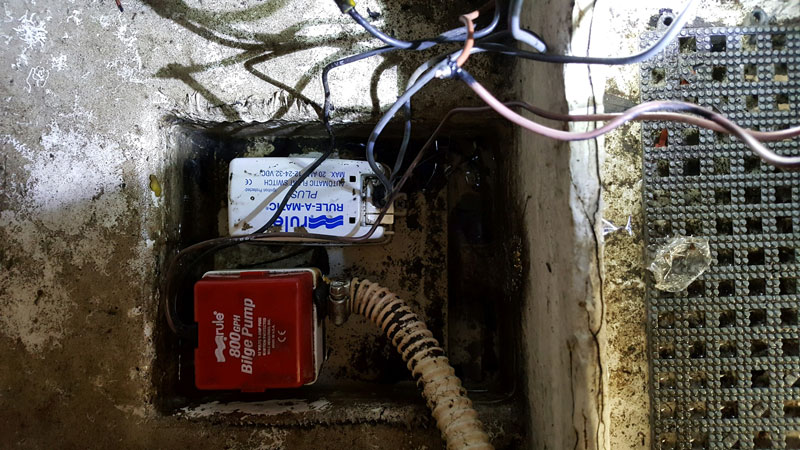Whether it’s a brand-spanking-new triple-engine Glitzcraft 1000 or a chalky water-stained wreck of a fishing machine, your fishboat is your fishing freedom. It gets you access to endless angling adventures, allows you to target the fresh fried fish dinner of your choice, and lets you vote with the throttle when the bite is slow. But only if it runs. And boats are notoriously famous for not running.

Never fear, dear angler. We can take measures to keep that boat running reliably, season after season. Will they ensure 100-percent reliability? Heck no. But, will proper maintenance vastly reduce the number of issues you’ll have? Heck yes. Thus, consider these five critical fishing boat maintenance measures.
1. Flush, Flush, Flush Your Motors – If you’ve been reading FishTalk for years, you’ve already heard us expound on this issue and know that flushing your outboard after use in saltwater is mandatory. But few boat owners flush properly, and on a regular — nay, religious! — basis. The flushing should occur asap after use to prevent salt from crystallizing and becoming tougher to rinse away. Five minutes of flowing freshwater is the minimum amount of time required to wash away all the salt deposits, and if you’re flushing after an hours-long ride home and know crystalized salt will need to be dissolved, double the flush-time.
Freshwater flushing will keep your engine’s interior water passages clear and corrosion-free. It will also prevent salt deposits from forming in the water pump, where they’ll grind on the impeller the next time you start up. It’s the single most critical maintenance task for any raw-water cooled fishing boat engine, period, so forgive us for harping on it over and over. And for gosh sakes anglers, if you’ve heard this time and again yet still don’t flush, it’s high time you changed your ways.
2. Corrosive Care – While keeping the engine running is a concern second only to keeping the boat floating, the motor isn’t the only item aboard that needs protection from corrosion. Most people don’t wax metal pipework, but they should, because it provides a layer of protection that will delay pitting and corrosion. Remember, aluminum does have tiny pores and cracks in its surface, and this is where salt crystallizes and can eventually do damage. But wax fills in the gaps, so the salt rinses away.
Any sort of wax will be helpful in this regard, but most boat maintenance sharpies agree that an excellent product for this specific task is Woody Wax (editor’s note: this is the one I use and can vouch for its effectiveness). Another option you’ll hear some talk about is Collinite Metal Wax. Whichever you may favor, one thing is for sure: some level of protection is a heck of a lot better than none.
3. Corrosive Care, Take II – Another place where corrosion can do serious damage is in your boat’s wiring. In fact, in some situations wiring issues can end a fishing trip just as fast as motor problems. And boats have lots and lots of wiring. Everything from livewells to running lights need juice, and that means positive and negative connections at both ends.

In truth, an electrical system that was carelessly made in the first place will probably have issues no matter what you do. But assuming your boat was wired right from the start with connections made via crimp connectors protected by heat-shrink tubing, you can help extend its lifespan and keep corrosion at bay by spritzing a corrosion-inhibitor like CorrosionX or Boeshield T-9 on every exposed terminal and end.
Be careful with this stuff because it’s easy to overuse, which causes drips and sticky splatters that can discolor some surfaces. Use multiple short blasts instead of extended spraying, and keep paper towels handy for quick cleanup and/or removing over-spray.
4. Can You See Me Now? – Isinglass and clear vinyl curtains rarely get treated as they should, and as a result, they commonly become cloudy and difficult to see through after a few seasons of use. This may not seem like something that can shut you down, but after you run over that crab pot you didn’t see through the haze you might have a different attitude. Plus, it will certainly make running the boat more difficult and may force you to back off on the throttles when visibility is hindered by low light or fog.
The problem is that this stuff gets scratched rather easily, and a heap of micro-scratches results in that hazy gaze. “Cleaning” Isinglass and clear curtains with a dirty rag or (yikes!) a scrub brush is usually the cause. Another big offender is stowing them in a console or compartment where they rub fiberglass every time vibrations run through the boat. Stowing them flat in a garage or basement is problematic, too, because dust and grime settle on the surface and can cause damage when you wipe them off.
To care for them properly, always rinse away salt and contaminants with freshwater before wiping them down, and only use a clean microfiber cloth to do the wiping. Treating them with a dedicated protectant like Plexus will go a long way in extending their lifespan, too. When not in use take the curtains down, roll them up like a tube, and stow them on dry land where nothing will compress or flatten the material.
5. Dose the Supply – Treating your fuel with a high-quality additive is another thing we’ve harped on for years, but we’ll do it again right now because it’s too darn important to ignore. Ethanol is the bane of boaters, and since its introduction to our fuel supply it’s brought countless engines to a screeching halt. With each and every fill-up, bar none, dose that fuel.
No, not all fuel additives are equal. There are a ton of them on the market and some, including name brands that have been around for years, literally do more harm than good. We certainly haven’t tested them all extensively but we can point to a few winners we’ve had good luck with through the years. Techron Marine (editor’s note: this is what I’ve been using consistently for about four years and currently use today) does well on all fronts. Star Tron also provides excellent protection, and if you give it a week or so to percolate, even seems to rehabilitate fuel that’s causing problems to some degree. Formula X2 is the one to reach for when there’s existing water in your fuel, as it “eats” the water and removes it from the system.
If you take all these measures and treat your fishboat like a gem, might it break down and leave you sitting at the dock anyway? Well, sure. No matter how well you maintain a boat it’s still a mixing platform for saltwater, metal, electricity, dirt and grime, sunshine, and hopefully a bit of fish slime. All that stuff takes a toll and our fishing machines live hard lives. But take these five critical maintenance chores to heart, and your boat will serve you more reliably for longer than it would otherwise. It will thank you for it. It will love you. And it will give you the freedom you need to catch more, bigger fish.